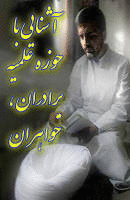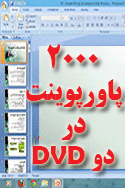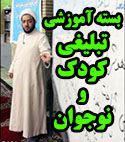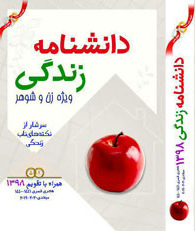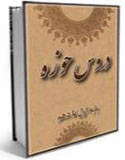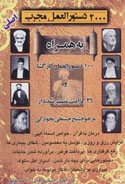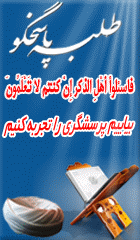'Man la yahduruh al-Faqih' by Al-Saduq
The Author
Al-Shaikh al-Saduq is the title given to Abu Ja'far Muhammad b. 'Ali ibn Babawaih al Qummi. He was the leading traditionist of his time (4th Century A.H.) and one of the most outstanding traditionists of Shi'ite Islam. He earned the title of al-Shaikh al-Saduq on account of his great learning and his reputation for truthfulness. It is a title which he also shares with his father.
Al-Shaikh 'Ali, the father of the author, was a leading figure among the scholars of Qumm. By the father's time the family were established as strong adherents of Shi'ite Islam. However, it is not known how early the family entered into Islam. [1]
Al-Shaikh al-Saduq is sometimes known as Ibn Babawaih. This is the family name and indicates the Persian origin of the family. For Babwaih is an Arabicized version of the Persian form Babuyah. [2]
The date of al-Shaikh al-Saduq's birth is not known exactly. However an interesting story surrounds the circumstances of his birth. When his father was in Iraq, he met Abul Qasim al-Husain b. Rawh, the third agent of the Hidden Imam. During their meeting he asked the latter several questions. Later he wrote to al-Husain b. Rawh asking him to take a letter to the Hidden Imam. In this letter he asked for a son. Al-Husain sent back an answer telling him that they (the Hidden Imam and al-Husain) had prayed to God to ask Him to grant the request and he would be rewarded with two sons. Another version of the story says three sons. The elder, or eldest, of these sons was Muhammad, that is al-Shaikh al-Saduq, our author.
On the basis of this story, early Shi'ite scholars have placed his birth after the year 305 A.H. probably 306 A.H. For al-Husain b. Rawh was the agent of the Hidden Imam from 305 A.H. until his death in 326 A.H. Al-Shaikh al-Saduq was born and grew up in Qumm. He was educated by his father and came into close contact with all the leading scholars of Shi'ite Islam in Qumm and studied under many of them. [3]
Qumm was one of centres of the study of Shi'ite traditions and it was this form of religious learning which held great influence over al-Shaikh al-Saduq. He travelled widely visiting many cities in search of traditions and as a result the number of scholars whom he learned traditions from is considerable. The number is put at 211.
The importance of traditions is emphasized by al-Shaikh al-Saduq and he quotes traditions against speculative theology. His works reflect this interest in traditions and nearly all of them take the form of compilations of traditions. However he did write a creed of Shi'ite Islamal-I'tiqadat.His pupil, the eminent theologian al-Shaikh al-Mufid, wrote a correction of this creedTashih al-i'tiqadwhere he criticises him on several points. [4]
The number of al-Shaikh al-Saduq's works is considerable. [5]
Al-Tusi says that they numbered over 300 but list only 43 of them that he has immediately in his possession, while al-Najashi lists 193 of them. Curiously enough al-Najashi does not mention the important workMan la y'ahduruh al-faqih!Many of the works of al-Shaikh al-Saduq have been lost but a considerable number survive and have been published. There are also other works not yet published but extant in manuscript form. As has been mentioned during his life al-Shaikh al-Saduq devoted most of his energy to the collection and compilation of traditions; he was also a great teacher of tradition. During the last years of his life al Shaikh' al Saduq lived in a Rayy. He had been invited there by the Buyid Rukn al Dawla. [6]
He seems to have been well-treated and honoured there by Rukn al-Dawla and took part in many discussions with him. However it is reported that his teaching was eventually restricted by the BuyidWazirIbn 'Abbad. The attack appears to have been aimed at traditions for several Sunni traditionists also suffered similar restrictions at the hands of Ibn 'Abbad. [7]
Al-Shaikh al-Saduq died in al-Rayy in 381 A.H. and he was buried there. He was probably more than 70 years of age. He left behind him many collections of traditions which are of great importance.
Man la yahduruh al-faqih
This work is included in the four major books of the traditions of Shi'ite Islam Despite the fact that many of his other works are extremely important, this book must be regarded as his most important work However some authorities maintain that there were five major books of traditions and they include another of al Shaikh al Saduq's worksMadinat al-'ilm,in this number.[8]
Al-Tusi mentions that the latter work was bigger thanMan la yahduruh al-faqih. [9]
It appears that this book is no longer existant. It seems to have been concerned with usul al-din (the principles of religion) rather than the furu', which are the practical regulations for carrying out the shari'a, the holy law of Islam.
As its title impliesMan la yahduruh al faqihwas concerned with furu'.It has be neatly translated by E. G. Brown as "Every man his own lawyer" [10]
In his introduction to the book al-Shaikh al-Saduq explains the circumstances of its composition and the reason for its title. When he was at Ilaq near Balkh, he met Sharif al-Din Abu 'Abd Allah known as Ni'mah whose full name was Muhammad b. Al-Husain b. Al-Husain b. Ishaq b. Musa b. Ja'far b. Muhammad b. Ali b. Al-Husain b. Ali b. Abi Talib. He was delighted with his discourses with him andh his gentleness, kindness, dignity and interest in religion. He brought a book compiled by Muhammad b. Zakharia al-Razi entitledMan la yahduruh al-Talibor "Every man his own doctor" to the attention of al-Shaikh al-Saduq. He, then, asked him to compile a book onfiqh(jurisprudence),al-halal Wa-'1-haram(the permitted and prohibited)al-shara-i' wa-'l-ahkam(revealed law and (ordinary) laws) which would draw on all the works which the Shaikh had composed on the subject. This book would be called Man la yahduruh al-faqihand would function as a work of reference. [11]
In fact the work represents a definitive synopsis of all the traditions which al-Shaikh al-Saduq had collected and included in individual books on specific legal subjects. In the lists of books of al-Shaikh al-Saduq, individual works are attributed to him on every subject of thefuru';examples are such works asKitab al-nikah"Book of Marriage" orKitab al-hajj"Book of the Pilgrimage". That this was the intention of both the author and the learned member of Ahl al-bait is emphasised by the author when he says that Sharif al-Din had asked him for this work despite the fact that he had copied or heard from him the traditions of 145 books. [12]
Another element in the work that stresses that it was conceived as a reference book to help ordinary Shi'ites in the practise of the legal requirements of Islam is the general absence of theisnadsfor traditions. Theisnads- or the chain of authorities by which the tradition had been received from the Prophet or one of the Imams - was, and is, an all-important feature of the science of traditions. Therefore this book was not meant to be a work for scholars, who would want to check the authorities. Scholars could check theisnadsin the numerous individual studies compiled by al-Shaikh al-Saduq. This book was a summary of the study of legal traditions by one of the great scholars of traditions. Al-Shaikh al-Saduq says that he complied with the request for him to compile the book "... because I found it appropriate to do so. I compiled the book withoutisnads (asanid)so that the chains (of authority) should not be too many (-and make the book too long-) and so that the book's advantages might be abundant. I did not have the usual intention of compilers (of books of traditions) to put forward everything which they (could) narrate but my intention was to put forward those things by which I gave legal opinions and which I judged to be correct. [13]
Al-Shaikh al-Saduq also gives an account of some of the earlier works which he referred to. These works were the books of Hariz b. 'Abd Allah al-Sijistani - he died during the life time of Imam Ja'far al-Sadiq; the book of 'Ubaid Allah b. 'Ali al-Halabi - who was also a contemporary of Imam Ja'far; the books of Ali b. Mahziyar - who took traditions from Imam 'Ali al-Rida, Imam Muhammad al-Jawad and Imam al-Hadi; the books of al-Husain b. Sa'id - who also heard traditions from those three Imams; theNawadirof Ahmad b. Muhammad b. 'Isa - who died in 297 A.H. and also heard traditions from those three Imams; theKitab nawadir al-hikmaof Muhammad b. Yahya b. 'Imran al-Ash'ari;Kitab al-rahmaof Sa'd b. 'Abd Allah - who died in 299 A.H. or 301 A.H.; theJami'of Muhammad b. al-Hasan - who was one of the teachers of the Shaikh and died in 343 A.H.; theNawadirof Muhammad b. Abi 'Umayr - who died in 218 A.H.; theKitab al-Mahasinof Ahmad b. Abi 'Abd Allah al-Barqi (i.e. Ahmad b. Muhammad b. Khalid al-Barqi) who died in 274 A.H. or 280 A.H. (this book has been published in Teheran); and theRisalawhich his father had written to him. The Shaikh goes on to mention that he also consulted many other works whose names occur in the book-lists. [14]
This inclusion of the list of some of the works consulted is useful evidence that the works of both al-Shaikh al-Saduq and his predecessor, al-Kulaini, who compiled the first of the four major books of Shi'ite traditions,al-Kafi,represent the culmination of works of traditions which had been compiled in a continuous process from the earliest times and at least from the time of Imam Ja'far al-Sadiq.
In addition to these references which the author gives in his introduction he frequently refers to his own works during the course of the book. Thus at the end of hisBab nawadir al-hajj(Chapter of Exceptional Traditions of the Pillgrimage), he says: "I have published these nawadirwithisnadswith others inKitab jami', nawadir al-hajj." [15]
Another feature of the work is the method used by the author. He does not leave the traditions to speak for themselves but frequently draws rules from the traditions or explains their meaning. In a summary of the various traditions on the pilgrimage, he gives a long outline of all the rituals which should be performed by the faithful with very few traditions intervening in his outline. [16]
The book covers most of the points concerned with thefuru' (practices) offiqhjurisprudence. It is not arranged in chapters(kutub)but in smaller sections(abwab), with the various categories such as fasting and pilgrimage following closely after each other. As indicated, its lack ofisnadsand al-Shaikh al-Saduq's own explanations make it an extremely useful compendium of law for ordinary Shi'ite Muslims of the period.
The book, naturally as one of the four major works of traditions, has had many commentaries written on it. Among the great Shi'ite writers who have written such commentaries are al-Sayyid Ahmad b. Zain al-'Abidin al-'Alawi al-'Amili (died 1060 A.H.) and Muhammad Taqi al-Majlisi al-Awwal (died 1070 A H ). [17]
The book itself has been recently published in four volumes in Teheran.
Notes:
1.Cf. "Introduction" by al-Sayyid Hasan al-Musawi al-Khurasan in his edition ofMan la yahduruh al-faqih(4 volumes Teheran, 1390), I, pages h-w
2.A. A. Fyzee,A Shi'ite Creed(Calcutta, 1942), p.8 footnote 2
3.Cf. al-Sayyid Hasan al-Musawi al-Khurasan, "Introduction",op cit,I, pages z-t
4.W. Madelung, "Imamism and Mu'tazilite Theology",Le Shi'isme Imamite,(Paris 1970), 21
5.Al-Shaikh al-Tusi,al-Fihrist (Mashhad 1351 A.H.S.), 303
6.Cited by A. A. Fyzee,op cit., 11, 16
7.Cited byW. Madelung,op cit.,20
8.Al-Sayyid Hasan al-Musawi al-Khurasan,op cit.,page Ar
9.Al-Shaikh al-Tusi,loc cit
10.Cited by A. A. Fyzee,op cit., 6
11.Man la yahduruh al-faqih,I, 2-3
12.Ibid, I. 3
13.Ibid
14.Ibid, I, 3-5
15.Ibid, II, 311
16.Ibid, II, 311
17.For a full list cf. "Introduction",ibidpages Aba-Ana
مطالب مشابه با این موضوع:
وبگــــــــــردی طلبۀ پاسخگو
- فایل اعمال و رفتار های خلاف قانون جناب آقای حسن روحانی
- در کنج خانه طلبهها چه میگذرد؟
- سکوت چند ساله مسئولان حوزه در قبال حملات وحشیانه به طلاب!
- می گویند که مملکت مملکت آخوندهاست!!
- یک ماجرای تلخ که خانم ها با تأمل بیشتر بخونند
- جریان های تکفیری موجود در عراق و نحوه شکل گیری آنها
- سیر تکاملی تفکر سلفیه چگونه بوده است؟
- بداء در قرآن و حدیث چگونه مطرح شده است؟
- پیامبر (ص) با مخالفین خود چگونه بر خورد می کرد؟
- سبک زندگی حضرت زهرا سلام الله علیها
- ملاک کرامت و شرافت افراد، انسانیت است یا جنسیت؟
- رنگ و پوشش های رنگی در اسلام
- حجاب، زنان را افسرده میکند و مانع پیشرفت اجتماعی آنهاست!!!
- علوم لدنی معصومین
- مگر ولی فقیه معصوم است که ولایت مطلقه دارد؟
- اگر خدا ازعاقبت ما اطلاع دارد قیامت برای چیست؟
- آیا بجای نماز خوندن، پیانو یا سه تار بزنم؟
- چرا مراسم عزاداري امام حسين(ع) پيش از شهادت ايشان صورت ميگيرد؟
- چرا امام حسين(ع) در كربلا براي رفع تشنگي از خداوند طلب باران نكرد؟
دانــــــلود های مفیـــــــــــــــــــد
- دانلود پاورپوینت شناخت وهابیت و صهیونیسم و ارتباط با همدیگر
- دانلود دو پاورپوینت اجرای عید غدیر خم
- دانلود پاورپوینت احتجاج اميرمؤمنان (ع) به غدير
- پژوهشی در کلام و پیام مقام معظم رهبری پیرامون ماه رمضان
- خطبه شعبانیه و خطبه امیرالمومنین(علیه السلام) پیرامون روزه و ماه رمضان
- دانلود پاورپوینت و pdf تفاوت های زن و مرد
- دانلود جزوه ساعات سعد و نحس(زمان نوشتن دعا)
- تقویم مذهبی شمیم یار 96 مخصوص کامپیوتر
- دانلود نرم افزار «شیعه شناسی»
- دانلود پاورپوینت ساختار خانواده و مسایل آن
- دانلود کتاب دایره المعارف جنسی
- دانلود نکات جذاب دوران عقد
- دانلود کتاب درمان سرد مزاجی و بی میلی جنسی بانوان
- دانلود کتاب حسادت کودکان
- دانلود کتاب درمان خستگی وناتوانی جنسی
- دانلود پاور پوینت اسیب های ازدواج وخانواده
- دانلود پاورپوینت هشت گام برای تحقق رویا به واقعیت
- دانلود پاورپوینت تقویت اراده
- دانلود پاورپوینت موفقیت وروشهای رسیدن به ان
- دانلود پاورپوینت هنر رفتار با افراد دشوار
- دانلود پاورپوینت جملات جالب وجذاب روحیه بخش بزرگان
- دانلود پاورپوینت راههای مقابله ودرمان استرس
- دانلود پاورپوینت نیازهای اساسی کودکان
منبــــرهای مکــــــــــــــــــتوب
- منبر مکتوب: روز عرفه و فرصت ها
- منبر مکتوب: سبک زندگی امام باقر علیه السلام
- منبر مکتوب: سه نیاز مومن (امام جواد علیه السلام)
- سخنرانی سلسله ای و چند جلسه ای مناسبت ماه رمضان
- دانلود 30 جلسه سخنرانی ماه مبارک با موضوع تنها مسیر
- موضوعات پیشنهادی سخنرانی برای محرم
- فضائل حضرت قمر بنی هاشم علیه السلام
- برکات وجود ابا عبدالله علیه السلام بر عالم
- بررسی بُعد اخلاقی،عبادی و عرفانی عاشورا
- آخرين وصيت امام حسين عليه السلام
- اولین علت رویاروی در کربلا؛ دوری از یاد خدا
- هميشه حزن؟ شادي چرا نه؟ - شب دهم محرم
- چرا نفرين ؟ - شب نهم محرم
- نماز ظهر عاشورا - شب هشتم محرم
- فلسفه عزاداری - شب هفتم محرم
- دفاع از دین - شب ششم محرم
- فلسفه حضور خانواده سيد الشهداء - شب پنجم محرم
- علم امام علیه السلام به شهادت - شب چهارم محرم
- فقدان شرایط امر به معروف و نهی از منکر- شب سوم محرم
مناظرات طلبه پاسخگو
جدیدترین های زبان انگلیسی
- Islam and Its Social System
- Duties of Man Towards the People
- Islam Various Systems
- Attributes of The Real Follower of Imams in Their Teachings
- Who is a Real Shia Muslim?
- RIGHTS OF SCHOLARS
- Islam Attacks Slavery 1
- The Advantages of Religion 2
- The Clearest Reason for Free Will
- Sheikh Zakzaky to be released on bail
- Brief History of Religions
- Is It Necessary For Man To Follow A Religion?
- The Advantages of Religion 1
- Who Is Almighty Allah?
- What are the differences between Shia and Sunni Muslims؟
- The Rights Islam Offers to Women
- How I find that Islam does not Oppress Women?
- URGENT MEDICAL TREATMENT FOR SHEIKH ZAKZAKY
- The motto of this year’s book fair is “Reading Is Ability”.
- Fundamental principles of Islam
بیشترین دانلود ها
- دانلود صوتي تکنیک های نزدیکی زن و شوهر (107745)
- دانلود رایگان کتاب خواص سوره های قرآن (53947)
- دانلود پاورپوینت بسیار مفید مهارت های زندگی (36770)
- دانلود كتاب مسائل جنسي و زناشوئي در احاديث (33194)
- دانلود پاورپوینت و pdf تفاوت های زن و مرد (32693)
- دانلود کتاب دایره المعارف جنسی (30782)
- دانلود پاورپوینت های آموزش پیش از ازدواج (29850)
- دانلود بسیار مفید پاورپوینت آئین همسرداری (29163)
- دانلود پاورپوینت آموزشی بررسی رابطه دختر و پسر (28831)
- دانلود 110جلد کتاب بحارالانوار علامه مجلسی ره (28657)
- دانلود كتاب دختران خوب به آسمان می روند دختران بد به همه جا (27741)
- دانلود کتاب آموزش جنسی آقایان (27678)
- دانلود كتاب فرق و مذاهب كلامي استاد رباني گلپايگاني (27598)
- دانلود کتاب درمان سرد مزاجی و بی میلی جنسی بانوان (26965)
- دانلود نکات جذاب دوران عقد (26469)
- دانلود نرم افزار «شیعه شناسی» (24791)
- دانلود کتاب درمان خستگی وناتوانی جنسی (24091)
- دانلود پاورپوینت روزه و روزه داری (22746)
جدیدترین مطالب سایت
- پاسخ به شبهات ولایت (4364) بازدید
- پاسخ به شبهات ولایت (4171) بازدید
- اذان در جامعه اسلامی نماد چیست ؟ و چرا فقط سه بار در روز تکرار می شود ؟ (3710) بازدید
- باتوجه به عادل بودن خداوند چرا بعضی از انسانها را ناقص الخلقه آفریده است ؟ (3782) بازدید
- ویژگی خاص قرآن چیست که کسی نمی تواند مانند آن را بیاورد ؟ (3877) بازدید
- با توجه به ترک خود ارضایی عوارض آن هنوز در من هست چگونه آن را برطرف کنم ؟ (5377) بازدید
- آیا بدن اخروی مانند بدن مادی است ؟چهره ی واقعی انسان در قیامت چگونه است ؟ (4685) بازدید
- آیا ادعای ملاقات امام زمان (عج) از جانب برخی افراد صحت دارد ؟ (4174) بازدید
- چرا به اصول و قواعد دین اسلام توجه نمی شود و پذیرش آن از سوی پیروان ادیان دیگر سخت است ؟ (4516) بازدید
- فلسفه وجود لباس روحانیت در عصر حاضر چیست ؟ (3389) بازدید
- آیا وظیفه یک روحانی تنها راهنمایی مردم و فعالیت و تدریس در حوزه هاست ؟ (2809) بازدید
- آیا نظریه تناسخ از دیدگاه اسلام پذیرفته شده است ؟ (4895) بازدید
- آیا توصیف بهشت و جهنم در قرآن تمثیل هایی برای درک بهتر آن جهان است ؟ (4482) بازدید
- با توجه به اینکه اسلام کاملترین دین هست چرا ما نسبت به کشور های غیر مسلمان عقب مانده تر هستیم ؟ (6441) بازدید
- نقش امام و رهبر در جامعه اسلامی چیست ؟ و اگر نباشد چه اتفاقی می افتد ؟ (4319) بازدید
پربازدیدترین های سایت
- زنی هستم که میخواهم به شوهرم خیانت کنم!!! (604929)
- آيا زن شوهر دار بخاطر رفع نیاز جنسی اش ميتواند صیغه شود؟ (500633)
- دوست دخترم حامله شده چکار کنم؟ (398340)
- میل جنسی زیادی دارم و به شدت داره منو عذاب می ده (340105)
- دیدن فیلم های مبتذل زن و شوهر برای تحریک شدن جنسی (217540)
- چگونه همسرمان را آماده آميزش جنسي كنم؟+18 (212881)
- حکم شرعی نزدیکی از پشت! (207764)
- خانم هایی که می خواهند طلبه شوند بخوانند!!! (205067)
- زنم رابطه جنسی برقرار نمیکند!!! (199429)
- از تجربه های تلخ و تکان دهنده دختران بخوانید شاید... (172189)
- گناه با محارم خود داشتم! (146055)
- رابطه جنسی دهانی حكم چيست؟ (130527)
- محرمات و مکروهات و مستحبات حائض+حکم ورد به امکان مقدسه (129284)
- به رابطه خانمم با خواهر زاده اش مشکوکم؟ (122855)
- سفارش اسلام در مورد آمیزش صحیح چیست؟ (98895)
- نام كتاب حضرت نوح و حضرت ابراهیم؟ (96736)
- با زنان چشم سبز ازدواج نکنیم؟ (94360)











